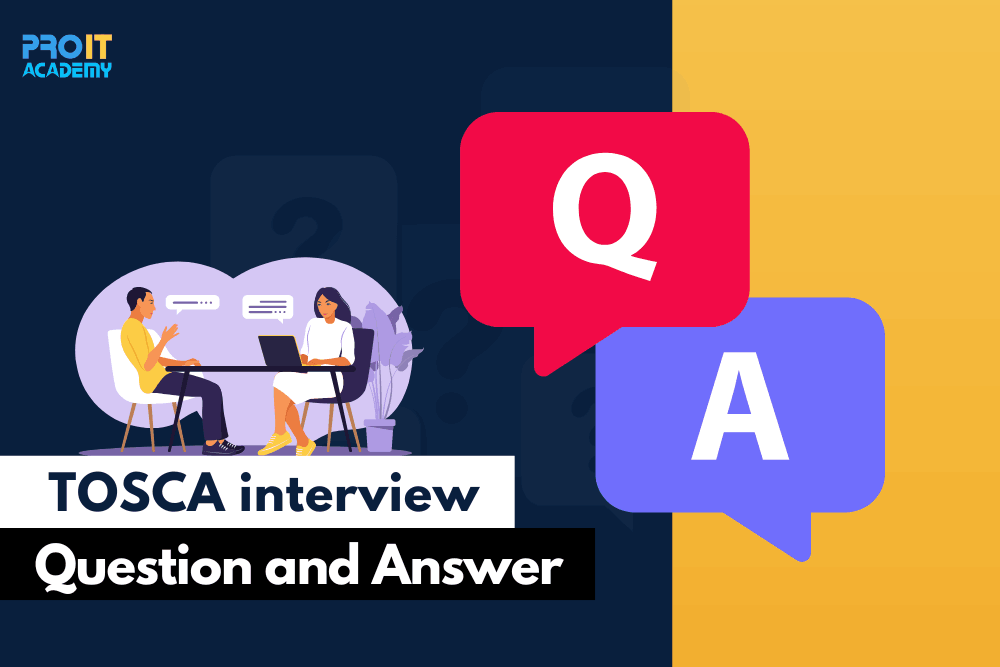In today’s rapidly evolving technology landscape, the management and orchestration of complex applications are critical for efficient deployment and scalability. TOSCA (Topology and Orchestration Specification for Cloud Applications) has emerged as a powerful standard for modeling, deploying, and managing applications in cloud and hybrid environments. Whether you are a beginner looking to enter the field or an experienced professional aiming to upgrade your knowledge, this blog post provides a comprehensive collection of TOSCA interview questions and answers to help you prepare for job interviews and enhance your understanding of the industry.
1.What is TOSCA?
TOSCA is an open standard language for defining the topology, configuration, and orchestration of cloud applications and services. It enables the modelling of complex application structures, their relationships, and deployment characteristics across several platforms.
2. What are the key components of TOSCA?
The key components of TOSCA include:
Service Templates: Descriptions of cloud services or applications.
Node Types: Definitions of individual components and their properties.
Relationship Types: Descriptions of relationships between components.
Artifact Types: Specification of files needed for the deployment of components.
Capability Types: Descriptions of the capabilities provided by a component.
Policy Types: Definitions of policies for governing component behavior.
3. How does TOSCA support portability and interoperability?
TOSCA promotes portability and interoperability by providing a standardised mechanism for describing cloud applications and services. By allowing users to create application models that are independent of specific cloud platforms, it facilitates the deployment and management of applications across a variety of settings.
4. What are the benefits of using TOSCA?
Some benefits of using TOSCA include:
- Application portability allows for the deployment of programs on different cloud platforms.
- TOSCA artifacts may be reused in a variety of applications.
- Automating deployment and administration processes is made possible with TOSCA.
- TOSCA makes it easier for various cloud services and tools to communicate with one another.
5. How does TOSCA handle application lifecycle management?
TOSCA defines application lifecycle management as a series of lifecycle actions, including creation, deployment, scaling, healing, and termination. On TOSCA service templates and the components that go with them, these operations are performed.

6. Explain the concept of “Relationship Types” in TOSCA.
Relationship Types explain the connections between various TOSCA service template components. They specify the nature of interactions between components, such as dependencies, hosting, and communications, as well as the way they interact with one another. Modelling complicated application architectures and their relationships is possible with Relationship Types.
7. How does TOSCA handle application scaling and elasticity?
TOSCA offers scaling and elasticity features through its “Capability Types.” These types of components enable components to specify features that enable dynamic scaling based on workload requirements by defining attributes like “min_instances” and “max_instances.” TOSCA orchestrators can use these features to automatically scale application component sizes.
8. What is the difference between “Node Types” and “Capability Types” in TOSCA?
In TOSCA, “Node Types” refers to the numerous components or nodes of an application, such as web servers or databases. They define the characteristics and actions of those components. The features or functions that a component offers, such as load balancing or logging, are specified by “Capability Types,” on the other hand. Node Types employ Capability Types to describe their capabilities.
9. How can TOSCA templates be used for automated deployment?
TOSCA templates can be used for automated deployment by using orchestrators or deployment tools that are TOSCA-compliant. These tools translate the TOSCA templates, resolve dependencies, and automatically deliver and configure the required resources and components in line with the defined topology and configuration.
10. Can TOSCA work with both cloud-native and traditional applications?
Yes, TOSCA is compatible with both traditional and cloud-native apps. Regardless of the environment in which they are deployed, it offers a versatile and extensible paradigm that can be used to define different kinds of applications and services.
11. Can you explain the concept of “Policies” in TOSCA?
Policies in TOSCA are used to specify guidelines or restrictions that control how application components behave. They can be used on single components or collections of components. Security, performance, availability, and any other specific requirement can all be covered by policies. The definition of Policy Types, which outline the guidelines and requirements that components must follow, is supported by TOSCA.
12. How does TOSCA handle application monitoring and management?
TOSCA makes it possible to monitor and manage applications by allowing the integration of monitoring tools and management systems with the deployed application. Monitoring and management capabilities can be included in the TOSCA templates as separate policies or as a part of the component descriptions. As a result, actions can be taken in accordance with established policies, and application performance can be monitored in real-time.
13. What is the role of TOSCA orchestrators in application deployment?
TOSCA orchestrators play a significant role in the deployment of TOSCA-based applications. They comprehend the TOSCA service templates in addition to organising the provisioning, configuration, and upkeep of the required resources and components. By ensuring that the specified topology, relationships, and policies are followed during the deployment process, orchestrators promote automation and consistency.
14. Can TOSCA templates be versioned and updated?
Yes, TOSCA templates can be updated and versioned. Versioning enables you to track changes made to the templates over time and go back, if necessary, to previous iterations. A TOSCA template must be changed carefully to ensure compatibility and to manage the transition from the old to the new version. Version control software or particular TOSCA tools can be used for efficient management of template versions.

Book Your Time-slot for Counselling !
15. How does TOSCA handle application portability across different cloud providers?
TOSCA’s platform-neutral technique makes it possible to move applications between different cloud service providers. By abstracting the infrastructure and standardising the expression of applications, TOSCA facilitates the translation of application models to the specific requirements and APIs of various cloud platforms. It is simpler to transfer apps between clouds when TOSCA orchestrators or deployment tools manage the mapping and deployment procedures.
16. Are there any specific TOSCA implementation challenges to consider?
While TOSCA offers several benefits, there can be implementation challenges to consider. he complexity of building and administering TOSCA templates, the requirement for TOSCA-compliant platforms and tools, and potential variations in TOSCA support across different cloud providers are a few concerns. To effectively utilise TOSCA’s potential, you may also need training and experience due to the steep learning curve connected with it.
17. How does TOSCA handle cross-cutting concerns, such as security and compliance?
TOSCA provides the flexibility required to address problems with a variety of aspects such as security and compliance, through the use of policies. Security rules can control access control, encryption, and other security measures. Policies for compliance can be used to make sure that the application complies with corporate or statutory requirements. TOSCA orchestrators or tools that are policy-driven can apply these policies during deployment and runtime.
18. Can TOSCA integrate with existing configuration management tools?
Yes, TOSCA is compatible with the latest configuration management tools. TOSCA templates can contain references to or actual configuration management scripts, like Chef or Puppet, to automate component configuration during deployment. This connection enables access to TOSCA’s higher-level application modelling capabilities while retaining the use of the existing processes and tools. Enroll in Software Testing Course in Pune and get placed with a reputed company.
19. How does TOSCA handle application upgrades and rollbacks?
TOSCA offers application upgrades and rollbacks using versioning and lifecycle management. When a new version of an application is released, TOSCA orchestrators are able to control the deployment of the upgraded components while ensuring that ongoing deployments are not disrupted. The TOSCA orchestrators can initiate rollback operations in the event of issues or the need to go back to a previous version by using the previous versions of the TOSCA templates.
20. Are there any TOSCA-related community resources or initiatives available?
Yes, there are several community resources and initiatives related to TOSCA. The OASIS (Organization for the Advancement of Structured Information Standards) TOSCA Technical Committee is responsible for maintaining the TOSCA specification. There are also open-source projects, such as the Alien4Cloud, Cloudify, and OpenTOSCA projects, which provide TOSCA-compliant tools and frameworks. Additionally, online forums, user groups, and blogs dedicated to TOSCA offer platforms for knowledge-sharing and collaboration
21. Can TOSCA be used for the management of containerized applications?
TOSCA makes it feasible to manage containerized applications. Kubernetes pods and Docker containers are two examples of containerized components whose topology and connection may be described using TOSCA templates. The deployment, scaling, and management of containerized applications can be handled by TOSCA orchestrators by specifying the appropriate properties, dependencies, and policies. This offers a consistent and standardised approach across various containerization platforms.
22. How does TOSCA handle application monitoring and logging?
TOSCA may work with a range of monitoring and logging systems to handle application monitoring and logging. TOSCA templates may contain policies or configuration details that specify the required logging and monitoring tools. TOSCA-compliant orchestrators can then begin the installation of monitoring agents or integrate with external monitoring systems to monitor the application’s performance, resource utilisation, and log events for analysis and troubleshooting.
23. Can TOSCA templates be integrated with external configuration management tools?
Yes, the integration of TOSCA templates with third-party configuration management tools is possible. Using TOSCA, configuration management artefacts and scripts may be incorporated into the application model. By using popular configuration management tools like Chef, Puppet, or Ansible, you may automate the provisioning and configuration of components during deployment with the aid of this integration.
24. How does TOSCA handle cross-cloud orchestration and deployment?
TOSCA enables cross-cloud orchestration and deployment by providing a description of cloud applications that is platform-independent. TOSCA-compliant orchestrators can understand and deploy the application across different cloud providers once the application architecture and deployment details have been described using TOSCA templates. This makes it possible for application deployment and management to go smoothly in multi-cloud or hybrid cloud systems.
25. Can you explain the concept of “Lifecycle Operations” in TOSCA?
Lifecycle operations in TOSCA reflect the various operations that can be performed on components throughout the course of their lifetime. This includes processes like creation, provisioning, deployment, scaling, healing, termination, and others. TOSCA orchestrators can perform these actions in response to predefined policies, events, or user requests to ensure that the application components are successfully managed and maintained throughout their lifecycle.
26. How does TOSCA handle application recovery and fault tolerance?
TOSCA addresses application resilience and fault tolerance through its support for policies and relationships. Policies can outline the requirements for fault tolerance, such as redundancy or automatic failover methods. It is possible to create component interactions that ensure effective fault tolerance and recovery methods. The interpretation of these policies and relationships by TOSCA orchestrators enables the automatic handling of failures and the restoration of application functions.

Do you need help to create your career path ?
27. Is TOSCA suitable for large-scale, distributed applications?
Yes, TOSCA is suitable for large-scale, distributed applications. TOSCA’s hierarchical structure and support for intricate topologies make it possible to model complex architectures with a variety of components and services. Tosca templates can be used to plan and manage large-scale distributed applications by illustrating the dependencies and communication patterns between different components.
28. Can TOSCA support the management of complex network configurations?
Yes, TOSCA can manage complex network configurations because to its network-specific features and relationship definitions. TOSCA templates can be used to specify network topologies, connectivity needs, and network policies. By creating connections between components and networks, TOSCA orchestrators can provide and configure the necessary network resources, such as virtual networks, subnets, security groups, and routing settings, to suit the application’s networking needs.
29. Can TOSCA templates be used for application testing and quality assurance?
Yes, TOSCA templates can be used for and application testing quality assurance. By indicating the ideal application state in the TOSCA template, provisioning and configuration of test environments may be automated. The application can be deployed in the proper state using TOSCA orchestrators, allowing for thorough testing, performance analysis, and quality assurance methods. To master TOSCA skills from experts check ProIT Academy‘s Software Testing Course.
30. How does TOSCA handle compliance and auditing requirements?
TOSCA can satisfy the needs for compliance and auditing by integrating policy definitions and monitoring capabilities. To build compliance policies that uphold organisational or regulatory requirements, use the TOSCA templates. By enforcing these rules throughout application deployment and runtime, TOSCA orchestrators can guarantee application compliance with the defined compliance standards. Furthermore, TOSCA templates may incorporate monitoring configurations that keep track of important audit logs and metrics for compliance reporting.












